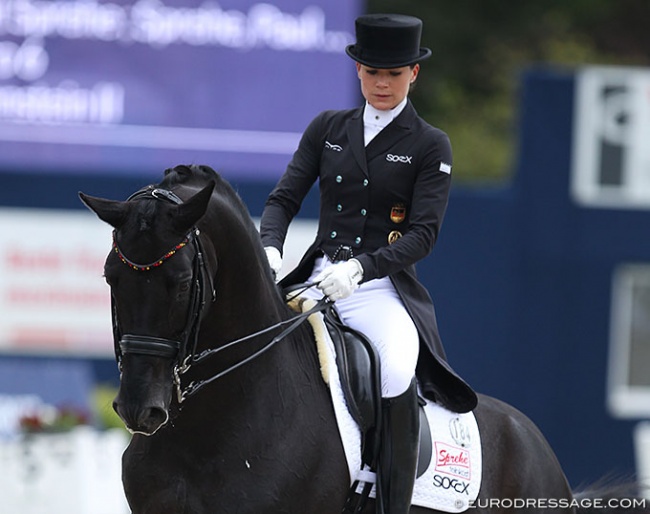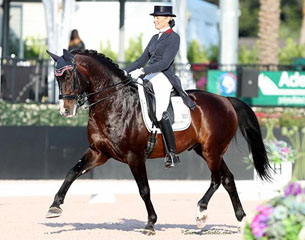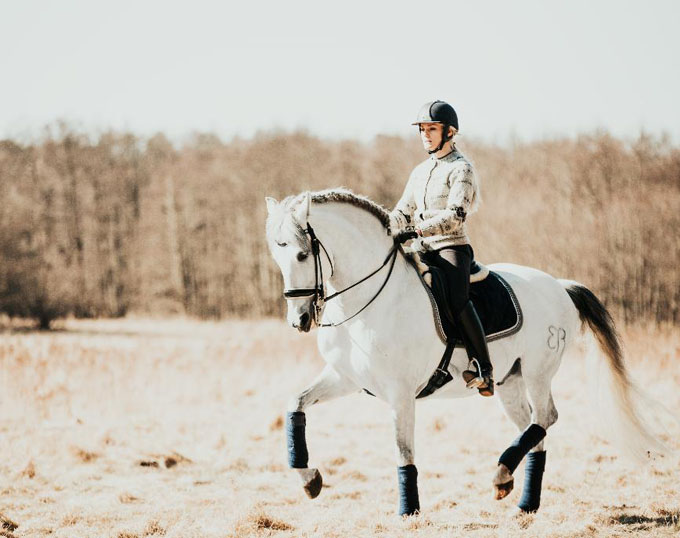
This fascinating and important subject is a follow up to last week’s article “Christoph Hess: The Most Important Part In Training a Horse is the Training of the Rider’s Position.”
Seat expert Dave Thind will elaborate on this subject:
The Harmonious Seat
Nothing improves our riding as much as time well spent in the saddle. The right horse and the right trainer make that possible. As in other sports, the measurable objective of physical fitness is important. But let’s also consider the smaller nuances and coordination training that helps create rider-feel and timing. Essentially the nuts and bolts in the delicate and ever-evolving relationship between horse and rider.
In terms of biomechanics in sport, perhaps none is as complex as the biomechanics of when breeches meet saddle.
Riders of all disciplines and levels know about the importance of constantly working on improving their positions. Many, however, will work towards the concept of a perfect position without giving credence to the fact that riding is not about posture, but rather about harmoniously moving with one’s horse while performing specific functions in a biomechanically sound way.
Probably the biggest issue that riders face with regards to their seat… the misunderstanding that they must sit totally erect or even immobile. A good seat moves!
Good Seat Vs. Good Position
For most people the word ‘position’ means something along the lines of posture and alignment, while the word ‘seat’ tends to lend mental images of a deeper way of sitting, perhaps even a classical ideal attained by lunge lessons. The rider’s seat can limit its meaning to the pelvis and lower back; however, when classical texts mention seat, they mostly refer to the whole body and how it is used. A central idea related to seat is always supple, flowing movement and we are encouraged to continually develop our seats as a finely-tuned instrument of communication. Therefore, seat means so much more than position. Words have power.
This may seem irrelevant, but it is not. Replacing one equestrian term for another has the capacity to act as a catalyst for powerful shift in one’s riding. For this reason, I rarely use the term half-halt, because in most instances it has nothing to do with halting and the words half-halt can possibly influence riders to block the hind legs instead of reengaging or rebalancing. So I encourage you to think about the words you use to describe your seat and riding in general.
In Gustav Steinbrecht’s highly regarded classic The Gymnasium of the Horse, the author states:

And in a more recent text: “Every single joint in the rider’s body must be relaxed to allow the rider to sit in a supple position and in balance with the horse. Only then can the aids be applied effectively.” (Principles of Riding, The Official Handbook of the German Equestrian Federation).
It is clear that the main message here is that the rider’s seat is something dynamic. The horse’s center of gravity is not constant. Kinetic forces from the horse need to move through the rider. The rider can learn to filter this movement, but it has to go somewhere! For clarification and visuals, refer to out this video starting at minute 2:45
Coming back to our topic, a supple seat is needed to allow a horse to move correctly over its back, without blocking the horse. Blocking the horse, albeit unintentionally, can lead to training issues like not pushing enough from behind, a dropped back, unsteady connection, ‘rein lameness’ and in jumping this can also mean poor form and rails. A horse blocked by the rider can eventually develop soundness issues.
By improving your seat, you make the learning environment for your horse more comfortable and desirable. Your communication is heightened and it becomes easier and more likely to reach your training goals in a harmonious and classical way. And as Christoph Hess told us last week: ““The most important part of the training of a horse is the training of the rider's position. No rider is able to train a horse properly when they have not trained their seat. The rider has to learn to find the right position in the saddle; balanced and relaxed - and to be honest this is very difficult.” He also recommended the Dave Thind Method to help develop the rider’s seat.
In addition, if you have any pain, tension or fears, all can be improved with body awareness and Feldenkrais lessons. This of course while respecting your personal limitations.
Try This at Home
Here are three easy Dave Thind Method exercises that are designed to heighten body awareness and make new brain pathways. We will start with some body scans and weight-shifting experiments and then finally work to improve your hips and lower back for smoother riding.
1. Standing Scan

Take a general overall inventory of how your skeletal stacks up (alignment) while standing. Does one leg feel longer or shorter? Does one shoulder feel higher or lower? Do you sense your head is in the middle? And do you sense that the weight of your head is carried down your whole spine into the pelvis and the legs? Maybe or maybe not – but merely thinking about how whatever is structurally higher and is supported by the bones and joints underneath will help your nervous system let go of some unnecessary but habitual muscular effort. Rest by taking a short walk.
2. Weight Shift.
Discover your predisposed standing leg and your short and long sides.
While standing, slowly raise one arm towards the ceiling, following your hand with your eyes. Try both sides. Which one did you instinctively choose first? Did that side feel easier?
Do both sides again. This time, notice if you sense a slight weight shift onto one leg. It maybe that you shift onto the same side as the lengthening arm, or on the opposite leg. You my even do one of each variation (sending a shift to the same leg regardless of which arm goes up). This information is valuable, as it can help us learn about the leg we prefer to stand on (standing leg) whether we have easy options for dexterity and which is our short and long side. Just like our horses, we have a short and long side. This and a preference for a standing leg are important to ideal function; symmetry as such is not a goal, but rather options on both sides.
Do both sides again, noticing which side is easier and what is easier about it. Try not to bring attention to what you perceive as difficult or stiff. How smooth is the movement and your breathing when you try each side? Can you breathe and move in a way to make it smoother?
3. Pelvic clock
The next part will begin with a laying down scan. Practice the standing and laying down scans often and notice what changes day to day and what elements stay constant. https://www.youtube.com/watch?v=4n-352SJtsg
Once you do this lesson, consider coming back to your test movement by doing a standing scan (Exercise 1) and repeating the weight shifting (Exercise 2). Notice how you feel standing and walking. Enjoy your next ride and notice what your horse thinks of your new-found mobility and suppleness.
Helpful Tips
Move slowly and enjoy. Don’t interpret any ‘right’ or ‘wrong’ from the recorded lesson. Allow the changes to occur in your riding and daily life without trying. Our aim is to feed our nervous systems with a buffet of new possibilities – “gourmet movement!”
We learn these new possibilities or clarifications during an unmounted lesson and then we can more or less forget about them. You do not need to try to memorize things.
Don’t try too hard and let go of muscular effort. Think skeletal movement. We don’t want your sympathetic nervous system turning on flight/fight/freeze mode, as it will gladly do in a difficult situation. This also applies to your horse; all living things look for ease and avoid discomfort.
Current Offer

PRE stallion Artemis.
The course is done on your own time, but the first group Q & A and discussion will be Monday October 6. Students are encouraged to ask questions and share their experiences on the dedicated private student’s facebook page.
In honor of "No Stirrup November," the DTM’s cache of unmounted exercises will be available for a discounted rate through the end of the year. But the exclusive 50% offer is valid only until October 6.
For riders looking to effortlessly ditch their stirrups and move as one with their horse, the DTM’s Online Seat Course focuses on mastering the mechanics of the sitting trot, as well as unlocking improvements to the overall seat and intuitive ‘feel’ via movement biomechanics.
For more information: https://www.davethindmethod.com/copy-of-online-courses
Facebook: https://www.facebook.com/davethindmethod/
About Dave Thind
Born in Canada and trained in Germany, Dave Thind makes his home in Walpole, Massachusetts, as owner of Aspire Farm since 2013. Thind has himself competed at the Grand Prix level in dressage and jumping. He is a noted equestrian biomechanics authority, with several published articles and appearances as an expert guest or lecturer to his credit. He received his German 'Trainer A' license in 2007 with a nearly perfect score awarded to him from the German National Federation. He holds an International Trainer Passport Level III.
After a four-year long education and certification, Dave is a Guild Certified Feldenkrais® Practitioner. This means that Dave is able to teach Feldenkrais® Awareness Through Movement® (ATM®) and hands on Functional Integration® (FI®) lessons.